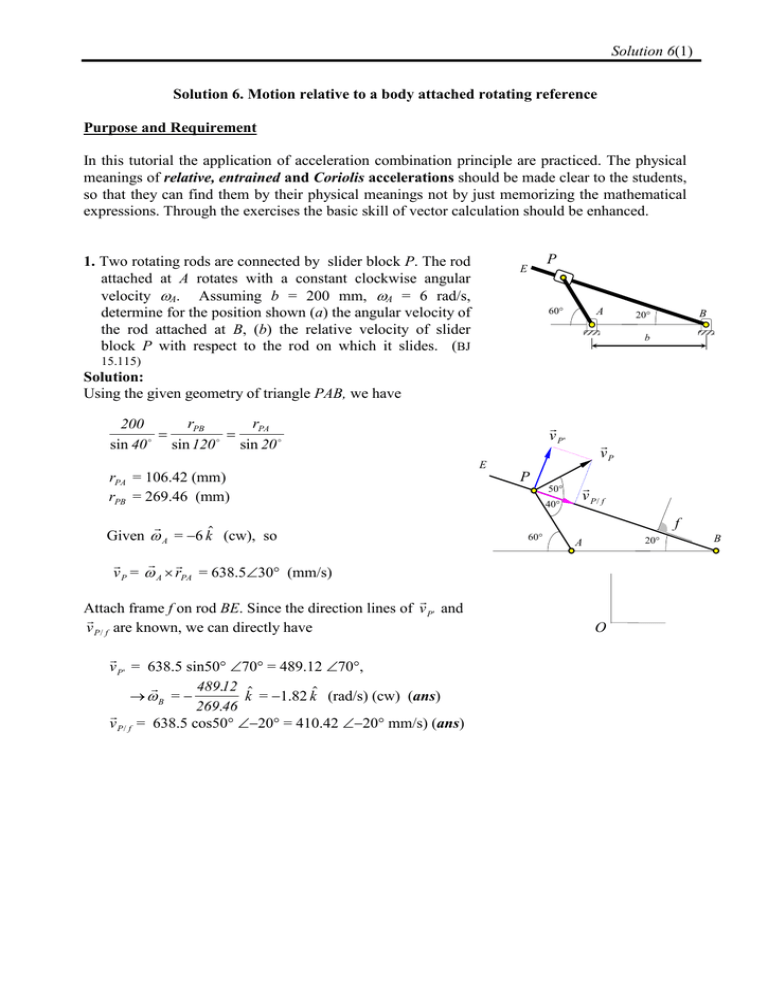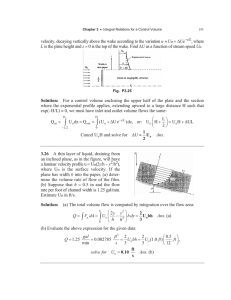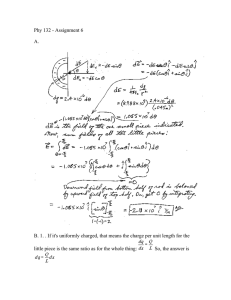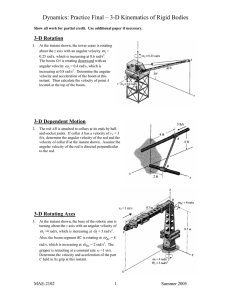Document
advertisement

Solution 6(1) Solution 6. Motion relative to a body attached rotating reference Purpose and Requirement In this tutorial the application of acceleration combination principle are practiced. The physical meanings of relative, entrained and Coriolis accelerations should be made clear to the students, so that they can find them by their physical meanings not by just memorizing the mathematical expressions. Through the exercises the basic skill of vector calculation should be enhanced. 1. Two rotating rods are connected by slider block P. The rod attached at A rotates with a constant clockwise angular velocity A. Assuming b = 200 mm, A = 6 rad/s, determine for the position shown (a) the angular velocity of the rod attached at B, (b) the relative velocity of slider block P with respect to the rod on which it slides. (BJ P E A 60 B 20 b 15.115) Solution: Using the given geometry of triangle PAB, we have rPB rPA 200 sin 40 sin 120 sin 20 v P' vP E rPA = 106.42 (mm) rPB = 269.46 (mm) Given A = 6 k (cw), so P 50 40 v P/ f f 60 20 A v P = A rPA = 638.530 (mm/s) Attach frame f on rod BE. Since the direction lines of v P' and v P / f are known, we can directly have v P' = 638.5 sin50 70 = 489.12 70, 489.12 B = k = 1.82 k (rad/s) (cw) (ans) 269.46 v P / f = 638.5 cos50 20 = 410.42 20 mm/s) (ans) O B Solution 6(2) y B 2m x O 3m 2. Block B moves along the slot in the platform with a constant speed of 2 m/s, measured relative to the platform in the direction shown. If the platform is rotating at a constant rate of =5 rad/s counterclockwise, determine the velocity of the block (a) at the instant =90, (b) at the instant =60. (H.16-148, p337) Solution: Set up O-xy and O-x”y”, which are coincide at the instant y,y” v B / f = 2 i , (a) Given v B/ f v B' rB' = 2 j , B = 5 k . x, x” O So we have v B' = rB' = 5(2) i = 10 i , v B/ f Ov vB vB v B' v B v B' v B/ f = 12 i (ans) Hence v B' y,y” (b) Give v B / f = 2 i , rB' =1.1547 i + 2 j , v B/ f 2m x, x” 60 = 5 k So we have v B' = rB' =5 k (1.1547 i + 2 j ) = 10 i + 5.77 j = 11.55 150 v B/ f vB Hence v B v B' v B/ f = 12 i i + 5.77 j v B' = 13.32 154.32 Ov (ans) Solution 6(3) 3. At the instant shown the length of the boom is being decreased at the constant rate of 150 mm/s and the boom is being lowered at the constant rate of 0.075 rad/s. Knowing that = 30, determine (a) the velocity of point B, (b) the acceleration of point B. (BJ 15.123) B 6m 30o A Solution: (a) Given rBA = 630 (m) v B / f = 0.15150 (m/s), = 0.075 k 60 18.4 v B' = rBA = 0.4560 (m/s) B v B/ f v B' f 30 vB A v B = v B / f + v B' = 0.47478.43 (m/s) (ans) (b) a B' = 2 rBA = 0.0752 (6) 150 a BC aB = 0.03375150 (m/s2) 120 56.31 aB/ f = 0 aB' a BC = 2 v B / f = 2(0.075)(0.15) 120 f 30 = 0.0225120 (m/s2) a B = a B' + a B / f + a BC = 0.04056(56.31+120) = 0.04056176.31 (m/s2) (ans) A B 150 Solution 6(4) A D C B 188 mm E 4. The hydraulic cylinder CD is welded to an arm, which rotates clockwise about A at the constant rate = 2.4 rad/s. Knowing that in the position shown rod BE is being moved to the right at the constant rate of 375 mm/s with respect to the cylinder, determine (a) the velocity of point B, (b) the acceleration of point B. (BJ 15.129) 250 mm Solution: Give O v B' = 2.4( k ) (rad/s) v B / f =375 i (mm/s) rBO = 312.8(36.94180) 188 B 36.94 (a) v B/ f 250 v B' = rBO = 2.4(312.8) (36.94+90) = 750.72126.94 = 451.2 i + 600.02 j (mm/s) vB v B' v B = v B / f + v B' = 76.17 i + 600.02 j Ov v B/ f a B' B = 604.897.23 (mm/s) (ans) (b) a B' = a Bt' a Bn' since a Bt' 0, v B2 ' n 36.94 = 1801.73 36.94 a B' = a B' = rOB a BC = 1440.06 i + 1082.8 j a B / f =0 a B' Oa aB a BC a BC =2 v B / f = 2(2.4)(375)( j ) = 1800 j a B = a B' + a B / f + a BC = 1440.06 i 717.2 j = 160926.5 (ans) Solution 6(5) 5. The platform (f) is rotating about a fixed point O with a constant angular velocity 0.3 rad/s counterclockwise. The particle P is traveling clockwise along a circular track with a constant speed 10 mm/s with respect to the platform. For the instant when the platform and the particle are at the positions shown, determine (a) the absolute velocity of particle P; (b) the absolute acceleration of particle P. Oy Answer: (a) 14.42-13.9o (b) 3.28102.2o 20 mm vP' Solution: Attach O”-x”y” on the plate P y” (a) v P v P / f v P ' P’ 40 mm v P" rPO =10,3930 O” 30 v P / f 10-60 x” vP / f f v P v P / f v P ' =14.42-13.9 mm/s (b) a P a P / f a P ' 2 v P / f a P ' 3.12120 a PC 2 v P / f =6 30 Oy 20 mm a P / f 5210 y” P 40 mm a P 3.28 102.2 mm/s2 O” 30 x” f vP / f


